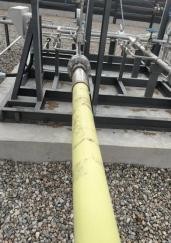
As hydrogen energy has been incorporated into the legal system as a "national strategic energy source", Chinese companies are striving to make more breakthroughs to bolster the development of this green and clean energy source, said a Chinese expert.
While Europe and the United States are weighing the transition from traditional energy sources to hydrogen, China has positioned hydrogen energy as the "petroleum zero-carbon era", competing to define the next-generation energy system, said Wei Yi, strategic development commissioner of Jiangsu Zhengdao Ocean Technology Co Ltd (ZTOC).
On Jan 1, 2025, China's new Energy Law came into force, marking the formal inclusion of hydrogen energy into the legal system, reinforcing its role in reshaping the country's energy landscape.
However, hydrogen transportation remains a technical barrier in moving from the lab to practical applications, as hydrogen gas with its small molecular weight is prone to leakage and has extremely high requirements for the gas tightness and strength of the pipelines, said Wei.
With the concept of "building the foundations for safe transportation of hydrogen energy", ZTOC — which was established in 1999 — is making its contributions in helping hydrogen transportation.
Wei noted that conventional steel pipes are susceptible to hydrogen embrittlement when exposed to high-pressure hydrogen for a long period of time — where hydrogen atoms penetrate into the metal lattice, resulting in a sudden drop in toughness, weakening material strength and even cracking, creating a major safety risk.
ZTOC has been committed to the development of an indispensable energy transportation pipeline, said Wei, stressing that since 2022, it has formally launched the research and development of core technology of hydrogen transportation pipeline through deep-rooted flexible pipeline design and manufacturing technology.
Through cooperation with China University of Petroleum and others, ZTOC has conducted in-depth research on the molecular behavior, aging mechanism and structural response characteristics in hydrogen environments from the material level, ensuring that each flexible pipeline has the best balance of safety, durability and cost-effectiveness.
So far, ZTOC has successfully developed thermoplastic reinforced composite pipes for hydrogen transport and mastered a number of key core technologies, with some results successfully filling the gaps in the country, said Wei.
At the moment, ZTOC has completed the research, development and performance verification of several types of flexible hydrogen pipelines, and has realized initial landing applications in many fields.
Currently, ZTOC Flexible Hydrogen Pipeline has been deployed in several green hydrogen production bases, wind-solar hydrogen storage integration demonstration projects, hydrogen port supply systems, with significant advantages, said Wei.
"It is imperative to build a hydrogen 'energy artery' to bolster green transport of hydrogen in the country, helping ensure the safety of large-scale delivery of green hydrogen," said Wei.
Please contact the writer at hanjingyan@chinadaily.com.cn

